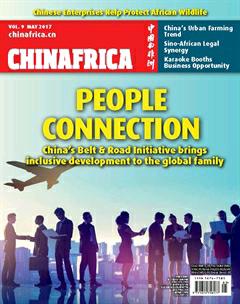Briefs
More Private Jobs Chinas growing service sector has provided a growing number of jobs as a result of economic restructuring, according to the National Bureau of Statistics (NBS). In 2016, the service sector employed 43.5 percent of Chinas workforce, up from 36.1 percent in 2012. Private firms have become the main source of new jobs, the NBS said. Jobs created by state-owned enterprises, however, witnessed a drop of 5.4 percent year on year as of the third quarter of 2016. In job creation, small enterprises outperformed medium and large ones, NBS said. During the period from 2012 to 2016, every percentage point of GDP expansion created 1.72 million new non-farm jobs in China, it added. China created 13.1 million new jobs for urban residents last year. The registered unemployment rate in Chinese cities stood at 4 percent at the end of 2016.
Q1 GDP Chinas economy posted a forecastbeating growth rate in the first quarter of 2017, with GDP up 6.9 percent year on year, according to data of the National Bureau of Statistics (NBS) released on April 17. The growth was above the full-year target of 6.5 percent and the 6.8-percent increase registered in the fourth quarter of 2016. GDP reached 18.07 trillion yuan ($2.63 trillion) in the January-March period.
NBS Spokesperson Mao Shengyong said the economy had achieved a rosy start this year. “Generally speaking, the national economy has continued with stable and sound momentum in the first quarter as growth rebounded moderately and economic adjustment was steadily promoted,” Mao said. He mainly attributed the strong performance to robust factory activity, strong consumption and rebounding exports.
Alipay Goes Abroad Alipay is rolling out its businesses abroad to provide the world with its own brand of mobile solutions. The popular payment tool was created in 2004 as a tool to allow transactions on Alibabas Taobao e-commerce platform. It has enjoyed exponential growth since, by introducing a string of financial products and services. Now, Alipay is accepted at more than 100,000 overseas merchants, including high-end shopping malls such as Harrods and Printemps, both magnets for Chinese consumers. In the latest national holidays, Alipay saw the number of its overseas transactions quadruple. Europe secured the fastest growth with 18 times year on year. Payment users have grown rapidly from 20 million to more than 140 million in less than two years, said Ni Xingjun, Vice Head of Alipay. Overseas expansion in the next few years will target economies along the Belt and Road Initiative, he stated. “We see the most pressing needs in Southeast Asian nations, because of a bigger population base and lack of credit card culture, which spells more opportunities,” he said.
Courier Delivery Tops China continued to lead the world in courier delivery volume in 2016, according to a report released by the State Post Bureau(SPB). China made up over 40 percent of global express delivery volume in 2016, contributing about 60 percent to the sectors growth, the report showed. The total number of packages delivered increased by 51.4 percent year on year in 2016 to more than 31 billion. Last year, couriers delivered over 4 trillion yuan ($580.8 billion) worth of retail sale products that had been bought online, accounting for 12.5 percent of total retail sales, the report showed. The delivery network expanded from 4.8 depots per 100,000 people and 6.7 depots per 1,000 square km in 2010 to 15 and 19.1 depots, respectively, in 2016, according to the report. Meanwhile, service quality improved, with fewer complaints.
More Profits for SMEs Chinas small and medium-sized enterprises (SMEs) saw rising net profits for 2016, despite slowing growth in the worlds second-largest economy. Average net profit of 1,598 SMEs listed on the National Equities Exchange and Quotations (NEEQ) hit 21.05 million yuan($3 million) last year, up 26.29 percent year on year. The SMEs, which delivered their annual reports at the end of March, posted an average annual business revenue of 212 million yuan ($30.7 million) in 2016, up 25 percent, according to NEEQ. Total assets of each company averaged 464 million yuan($67.4 million) at the end of 2016, up 23.9 percent year on year. SMEs ramped up their spending on research and development, which climbed 8.25 percent to 11.58 billion yuan ($1.68 billion) in 2016, with strategic emerging industries investing a total 4.03 billion yuan ($584 million), up 58.59 percent year on year.
Robotics Industry Growing China is poised to elevate its robotics industry, according to Xin Guobin, Vice Minister of Industry and Information Technology. More than 800 enterprises that provide products and services spanning electronics, machinery, chemicals and medical services have already laid sound foundations for the upgrade, Xin said. China produced 72,400 industrial robots in 2016, up 34.3 percent year on year. Sales are expected to exceed 50 billion yuan ($7.26 billion) in 2020, according to industry insiders. Xin said the ministry will further integrate new technology, improve the recruitment of talent, and support the use of robots in emerging industries. The ministry will expedite related regulations and industry organizations will offer guidance to local authorities, all in accordance with the plan of Made in China 2025. The plan was announced in May 2015 as a way to move manufacturing up in the value chain, promoting development in 10 key sectors including robotics.

